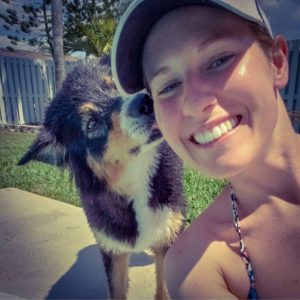You can’t get enough of your Australian Shepherd…well, until they start barking that is. So how do you stop your Aussie from barking?
It seems to you that your dog woofs at just about anything and everything, from a stranger at the door to the kids running too quickly down the hall. You’d like to curtail your Shepherd’s barking if at all possible, but how?
To stop an Australian Shepherd from incessantly barking, try one of the following methods:
- Pretend like you don’t hear the sound by turning your back to them, then offer a treat when your Shepherd stops barking
- Let your dog bark as much as they want, and when they stop, reward their silence with a treat
- Teach your Shepherd to bark on command, then quiet them when they get too loud
In this article, we’ll expand on the three methods above, giving you step-by-step instructions to follow. We’ll also talk about why Australian Shepherds bark a lot in the first place and what to do if nothing quiets your Aussie. Keep reading!
Why Do Australian Shepherds Bark So Much?
If it seems like your Australian Shepherd barks more than other dogs you’ve had in the past, that’s not just your imagination. This breed is especially known for its loud, sometimes non stop barking.
To understand why that is, we have to look back to the history of the humble Australian Shepherd. Since the 19th century when the Aussie was first bred, they were made to be livestock herders. This is part of where the dog gets its unending energy and enthusiasm.
In order to manage livestock, the Australian Shepherd can’t be a quiet dog. It must display authority, and besides its imposing size (to livestock, at the very least), one other way it does that is through barking. This tells the livestock where to go so they’re corralled to their destination.
Not only that, but the Australian Shepherd needs a strong, commanding owner who can give them things to do. Sure, you may not have any livestock in your yard to herd, but perhaps you throw a stick or ball. If not, the Aussie can get bored, and that’s when they may start ramping up their barking.
Failing to provide adequate exercise can also prove problematic, in that your Shepherd will begin to voice their displeasure through loud bouts of barking.
Besides what’s associated with the breed, your Aussie can bark for the same reasons almost any dog does. For example, maybe they vocalize to say hello (like to other dogs at the park), as a warning (if a stranger comes over or someone knocks on the door), or even out of fear (like during a thunderstorm).
How to Stop an Australian Shepherd from Barking: Three Useful Methods
As the last section proved, your Australian Shepherd will never be a completely mute dog. They just have too much energy, plus, it’s not in their lineage to stop barking completely. That said, you can ramp down excessive noise by trying one of these three handy methods.
Pretending You Don’t Hear Your Aussie
To get started with this first method, you’ll need plenty of treats. It’s also best if you’re in an area where your Australian Shepherd tends to bark more often. This may be by the front door or out in the yard.
Step 1: When you’re in the right area, hang out with your dog and let them do their thing. It will only be a matter of time before they begin woofing at everything in sight.
Step 2: Although your first reaction is going to be to quiet your Australian Shepherd, say nothing. Instead, physically turn yourself so your back is to the dog. Do your best to pretend you can’t hear them barking. That means stay relaxed instead of tense, don’t cover your ears, and again, don’t speak.
Step 3: Wait until your Aussie quits barking. When they’re completely silent, give them some of the treats you have on-hand.
Step 4: Keep this up when your dog gets into an especially barky mood. Instead of just giving the treats to your dog immediately though, stretch the time out more and more. This lets your dog know they will get a reward if they can be quiet and wait a little while.
Let Your Dog Get It Out of Their System
Allowing your Aussie to bark as much as he or she wants may sound incredibly counterintuitive, but bear with us. This method can work, but you need to do it correctly. To that end, you’ll again need your pup’s favorite treats.
Step 1: You don’t need to be anywhere special in this case, just let your Australian Shepherd go about their day as they usually do. Once again, you want to wait for them to start barking up a storm.
Step 2: This is the really hard part, but do nothing. Watch your dog so they don’t get aggressive or chase whatever they’re watching as they bark, but stay where you are.
Step 3: With no one reacting to their bark, your Aussie may stop even sooner than they usually do. You should have stuck by them this whole time, waiting for it to happen.
Step 4: Now reward your dog, giving them treats and telling them what a good girl/boy they are.
Step 5: Like the first method, keep doing this over the days and weeks to come. Your Shepherd will begin to understand that if they’re quiet, they’ll receive a treat. If they bark, they don’t. Once more, don’t just give the treat immediately. Make your Aussie wait for it to really reinforce the behavior. Bark on Command, Then Silence.
Teach Your Australian Shepherd To Speak
Our third method involves some training before you interject. You’ll yet again need treats. You may even want to leash up your Australian Shepherd if they get especially excited or even aggressive when they’re barking a lot.
Step 1: Make sure your dog knows how to speak when you ask them to. If they don’t, then this is what you want to focus on first.
Step 2: Next, teach your dog to be quiet. You want to say only that word, “quiet.” Make sure your tone is firm and authoritative. It may take a few days for your Aussie to grasp what this command means, but once they know it, you can use it to your advantage.
Step 3: In an environment your Aussie feels comfortable in, leash them up and tell them to “speak.” Your dog should begin barking.
Step 4: As soon as the barking gets started, say “quiet.” If you’ve trained your Shepherd well, they should listen immediately and stop barking.
Step 5: Pet your dog, verbally praise them and give them a treat for their great efforts.
Step 6: Keep repeating this, and–like with the other methods we’ve discussed–extend how long your Aussie has to wait before they get their treat. The goal of this training is to dissuade your dog from barking of their own volition, instead only doing it when you ask them or as a warning.
My Australian Shepherd Just Won’t Stop Barking; Now What?
Okay, so you spent weeks working with your Australian Shepherd on one of the three methods above. You may have even tried them all, but to no avail. It’s not that you haven’t trained your dog well, it’s just that they won’t stop barking. What should you do?
We recommend you take the time to determine why your Aussie is barking. If your dog is excitable when the mailman arrives, then sure, the methods above should be able to curb their noise. The same is true if it’s passing cars that set them off.
However, if your Aussie is trying to let you know they’re bored, lack exercise, or are stressed and in pain, then training them not to bark may not be as effective. While your dog can’t speak a language we understand, they are still communicating to you that something’s wrong.
You might want to schedule an appointment with your vet to ensure your Shepherd is in good health. If the barking persists even once you start playing with them more and you’re sure your dog isn’t injured or sick, you don’t have to give up. Instead, you may consider a professional dog training class for obedience.
Conclusion
Australian Shepherds are not the quietest dog breed. That said, you can train yours to be less noisy if you’re willing to put in the work and effort. Do make sure your dog isn’t barking due to an injury, illness, or stress, which can happen sometimes. Then use the methods we recommended. Best of luck with your Aussie and here’s to quieter days ahead.
PHOTO CREDITS IN THIS ARTICLE: Zoe Marie The Aussie via Instagram.





